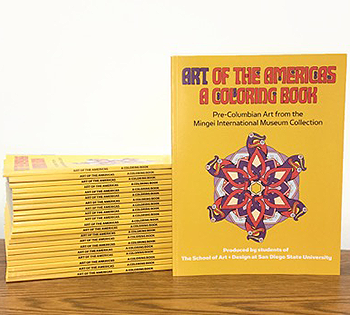Exhibit at Mingei International Museum Inspires Coloring Book
SDSU Art + Design students created pieces with inspiration drawn from exhibitions at the Mingei International Museum

April 30, 2018
By Anna Waletzko
Throughout the fall 2017 semester, more than 50 students and School of Art + Design faculty members worked to create the latest Arts Alive coloring book. The community-based project resulted in a coloring book, titled, "Art of the Americas, A Coloring Book of Pre-Columbian Art.” The coloring book was a collaborative effort between the Mingei International Museum, Arts Alive, Montezuma Publishing and students and faculty of the School of Art + Design.
The book features work inspired by the Mingei International Museum Collection and is filled illustrations created by students in multiple sections of the two-dimensional design courses. The course, Art 101, is an entry-level art course that welcomes art and non-art majors. The book was created and designed by School of Art + Design lecturer David Fobes, who also taught the course.
The exhibition, Art of the Americas, Pre-Columbian Art from Mingei’s Collection, was the basis for students’ research and final design projects. After being given private tours by museum curator Christine Knoke, students created their designs based on a piece of art displayed in the exhibition. The book is the product of creativity and academic research requiring students follow the assignment parameters and to meet print deadlines.
Inspiration was drawn from a variety of sources and items, including a tamale platter with origins in Panama between 800 – 1100 AD and a ceremonial axe dating back to 100 – 1550 AD during what is known as the Classic Mayan Period in Central America.
Within the pages of the book, readers will find a photo of the museum item with a description of the history, culture, and geographic location behind the piece. The corresponding page features the two-dimensional design, ready to be filled with color. The pages of the coloring book are filled with designs that focus on symmetry and motifs and includes a foreword by Professor Fobes describing the process of crafting the designs, which were created both traditionally and digitally.
The content within this article has been edited by Lizbeth Persons.
More PSFA Stories